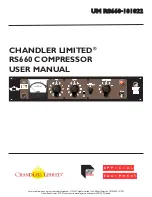
11
RS660-101022
MAINTENANCE INSTRUCTIONS
WARNING
:
HIGH VOLTAGE is used in the operation of
this equipment. DEATH ON CONTACT may result if safety
precautions are not observed. Disconnect any power to the
equipment prior to removing the top or bottom covers for
internal maintenance.
Valves
Valves (vacuum tubes) have been used in professional audio
application for decades. It is the valve’s ability to
clip
(signals
passing above a threshold and resulting in distortion), more
naturally than a transistor, and producing even ordered har-
monic distortion that recording engineers, producers and
artists crave.
Though valves can function for decades, no component is
infallible or immune to being compromised or failing in some
way; inconsistencies and or defects in manufacturing have a
role in the expected functionality and life expectancy of a
valve.
While Chandler Limited does not manufacture valves, we
select vacuum tubes for a circuit required specification, and
burn them in prior to deployment in the equipment; up to
40% of candidates are rejected for non-conformity. However,
valves — akin to a lightbulb — are considered expendables
and in the future, may require replacement by the equipment
owner.
For maintenance and replacement, valves have been sock-
eted.
Some indication that a valve may not be functioning optimally
are— increased noise, low gain and apparent loss of com-
pression.
If a valve is suspected of having been compromised or faulty,
and maintenance or replacement is necessary, please refer-
ence the service section of this manual for support contact
details.
For owner operators who are technically proficient in equip-
ment maintenance and valve replacement, the hardware is
field serviceable.
One common occurrence with valves is that they may be-
come noisy. Valve noise isn’t always an indication of compo-
nent failure, and can sometimes be a sign of oxidization of
vacuum tube contacts.
Only once the unit has been fully disconnected from power,
by disconnection of the IEC cable from the equipment chas-
sis, may the top cover be removed, may a valve be extracted
from the socket. If a valve presents visible oxidization, steel
wool may be used to gently to brush of any corrosion to
the valve contacts. After the tube has been evaluated and or
cleaned, re-seat the valve in the socket prior to moving on to
the next one; sometimes a simple re-seating of the valve in
the socket may remove any corrosion. If noise persists after
the prior maintenance regiment, it may be time for a tube to
be replaced.
VALVE
INVENTORY
QUANTITY
6386
1
6CG7
1
6AL5
1
Pilot Lamp
A pilot lamp is provided to indicate when mains power is
active. An incandescent light bulb is housed within a bayonet
type lamp fixture, and like any bulb, it may need to be re-
placed from time to time.
BULB TYPE
SPECIFICAITON
Dial Lamp #47 or equiva-
lent LED replacement
T-3-1/4, 6.3V, .15A, Bayo-
net Base
Only once the unit has been fully disconnected from power,
by disconnection of the IEC cable from the equipment chas-
sis, may the bulb be replaced.
To replace the pilot lamp light bulb, first remove the lamp
cover. In an anticlockwise motion, gently unscrew the cover
to reveal the light bulb.
To free the light bulb from the bayonet style base, using a
thumb, gently press the light bulb inwards and rotate it anti-
clockwise until it is released.
Once the failed light bulb has been removed, place the new
bulb in to the fixture and again, using a thumb, gently apply
pressure to the light bulb, and rotate it in a clockwise motion
until the light bulb is fastened in place.
Warning:
If the bulb is pressed inwards with too much pres-
sure, the bayonet lamp cradle may bend and the light bulb will
not illuminate when mains power is present.
If the bayonet lamp cradle is suspected of being bent, it may
be easily remedied from inside the chassis — only after pow-
er has been disconnected form the unit —, by gently applying
pressure to bend it back into form.

































